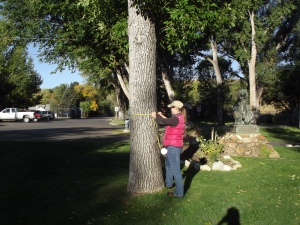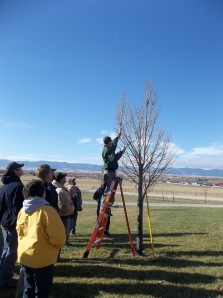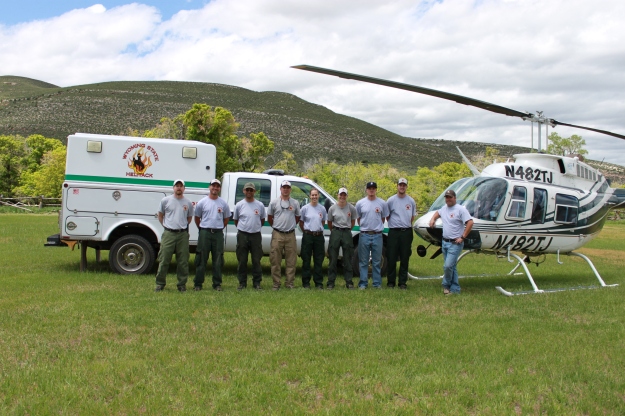
Kendrick Park, Sheridan, WY is an example of a mature, older park
Do you manage parks, cemeteries, golf courses or right-of-ways with aging mature trees? Are you concerned about what will become of these areas as the mature trees start to decline and become hazardous? Conversely, do you have new parks or recent additions to your town that have been planted in the last ten years? Have you stopped to think about the future of these trees and how their benefits can be maximized – ten, twenty, or forty years from now? What about all the tree care and maintenance activities that should be accomplished throughout their lifespan? In addition, are you looking for a way to document

Whitney Commons Park, Sheridan, WY is an example of a new park
all the tree work you have done and prioritize work for the future? This article will provide direction to assist you in developing a Tree Management Plan which can help guide you in the future. Wyoming State Forestry has the tools and skills to assist you along the way!
The first and most important step to a Tree Management Plan is conducting a tree inventory. How can you devise a plan to manage a population of trees without first understanding the trees themselves? An inventory provides in-depth information about each tree and provides tools to easily evaluate the data for a thorough analysis of your forest. Before you begin an inventory, it is important to determine what information you would like to get out of the inventory. Inventories can be time consuming so you should only collect the data necessary to assist you in your specific goals for the area you want to inventory. For example, you may want to determine the total value of the trees, to justify the cost of care and maintenance to your city council or mayor.

A diameter measurement is crucial to getting the total value of a tree. The total value of Kendrick Park at the time of inventory was $3,052,319!
Inventories can also provide the basis for developing future work plans. As data for each tree is collected, specific maintenance needs can be noted, including dates for completing this maintenance. Maintenance needs could include mulching, watering, wrapping, treating for a specific insect or disease, pruning, hazard inspection, and tree removal. After the inventory is completed and imported into a spreadsheet, you will be able to develop a yearly work plan from the maintenance recommendations you made while conducting the inventory. This maintenance schedule can assist with cost estimates and improve work efficiency. It also can be easily updated since it is in a spreadsheet form.
There is one additional data piece to consider before conducting an inventory- a GPS location (or waypoint) for each tree. GPS waypoints can be downloaded from numerous different types of software programs to produce informative maps. If you are collecting tree

Example of Whitney Commons Park Work Plan for 2013
data by paper and downloading waypoints only, ArcMap is a great program to use. After downloading the GPS tree waypoints, you can add in your excel spreadsheet that contains all your tree data and join that tabular data to the waypoints. This can be done by matching the tree’s specific ID in the excel spreadsheet with the same ID given to the GPS waypoint. The joined waypoints and table can be exported into a new shapefile that can then be shared with others. With the new exported shapefile, anyone can click on a waypoint and view all the information from the spreadsheet about the tree. Many handheld devices take care of this step all at once by collecting the waypoint and inventory data in one place, making a shapefile with tabular data downloadable and ready to share. A person can then use the new user friendly and FREE ArcGIS Explorer Online program.
Maps provide a visual view of your entire tree population and can also highlight trends or areas of concern. Maps are also a great way to share information with the public and

All inventoried trees in Kendrick Park. Note the selected tree and tabular information that was joined from a spreadsheet. The spreadsheet was brought into ArcMap and joined to the waypoint shapefile, then exported to make a final shapefile with waypoint and tabular data.
important leaders in your community. There is now a free internet website available called explorer.arcgis.com (or ArcGIS Explorer Online when Googled) that provides a venue to share maps to specific groups or to the public in general. Each map receives its own website that anyone can access and view. Once you access the ArcGIS Explorer online homepage, click on the “My Content” tab and select the button “Sign In”. This is where you will sign up so that you can set up your own personal account. When signing up you will be able to choose from signing up for a free 30 day ArcGIS online trial account or you can pick to create a public account. Either account will provide a place to keep all your created maps and data organized, but for this article’s purposes ArcGIS Explorer online will be explained, so you would be selecting to create a public account.
Setting up a public account is your starting point for creating your own inventory maps and also where you can find plenty of educational material about ArcGIS Explorer online. Making a map is pretty simple; you can begin by clicking on “New Map” tab located in the upper right hand corner of the screen. Then upload your zipped shapefile data and choose a basemap from the assortment of backgrounds that are available. You can easily edit your waypoint symbols and the pop-up display information by selecting the layers tab and then your shapefile in the table of contents area. This will bring you to your Layer Details and where you can make your edits. Once you have saved your map, you can share it with others. In order to share your map with others, click on the “Share” button at the top of the map. This provides you the actual map website that can be linked to Facebook or copied and pasted into presentations, handouts, or brochures. The options and methods of educating the public are endless with the use of ArcGIS Explorer Online. From setting-up mobile phone Apps to adding photos of each tree to their GPS location, you are able to better connect with a techno-based public about your community’s trees.

Planting is an important component of future management. Sheridan Arbor Day 2011 in Kendrick Park
After you have had a chance to analyze your inventory, work plan, and maps, the last piece to your Tree Management Plan is to focus on the future. What are the goals and objectives for your community forest? How are those goals or objectives to be implemented? Are there new project ideas that can be applied? For example, this is where you might include a future tree planting plan and targets for tree diversity. It is critical to make your goals and objectives achievable so that your Tree Management Plan is successful. Also think about continuing education for yourself and your maintenance staff. Wyoming State Forestry is committed to providing professional community forestry assistance to our local communities and can provide tree care workshops as well as aid in developing Tree Management Plans.
Example:
Kendrick Park Planting Plan:
Hopefully as a result of reading this article you have realized how critical a Tree Management Plan could be to your community. Make sure that all future goals,

Kendrick Park planting plan
recommendations, and implementation plans get documented in the Tree Management Plan, that way everyone can understand what you are trying to accomplish. It will become easier to apply for grants and ask for financial assistance for community forest costs when you are able to show why you need the support and how you plan to use it to accomplish your Tree Management Plan’s goals. I hope you have become inspired to move forward with this process and begin better managing your community forest. If you need assistance, Wyoming State Forestry is just a phone call away!
Kelly Norris is an Assistant District Forester with the Wyoming State Forestry Division. Stationed in Buffalo, she covers Campbell, Johnson and Sheridan counties. She can be reached at Kelly.norris@wyo.gov or (307) 684-2752.
 Once again, another field season is nearly over as we move into fall and winter. Reflecting back on this year, the first thing that comes to mind is, what a difference a little moisture makes! After the record breaking fire season of 2012, we enjoyed a relatively light fire season over most of Wyoming. The rest of the west didn’t fare so well. Oregon, Washington, Idaho, Nevada, and Montana all had heavy fire activity, and in late June, Arizona suffered the worst wildland firefighter fatality incident in nearly 100 years, with 19 members of the Granite Mountain Hotshots dying in a tragic burn over.
Once again, another field season is nearly over as we move into fall and winter. Reflecting back on this year, the first thing that comes to mind is, what a difference a little moisture makes! After the record breaking fire season of 2012, we enjoyed a relatively light fire season over most of Wyoming. The rest of the west didn’t fare so well. Oregon, Washington, Idaho, Nevada, and Montana all had heavy fire activity, and in late June, Arizona suffered the worst wildland firefighter fatality incident in nearly 100 years, with 19 members of the Granite Mountain Hotshots dying in a tragic burn over.











